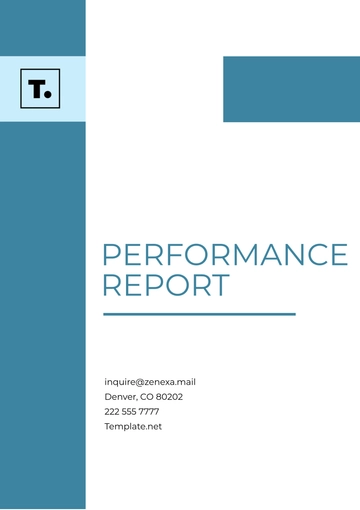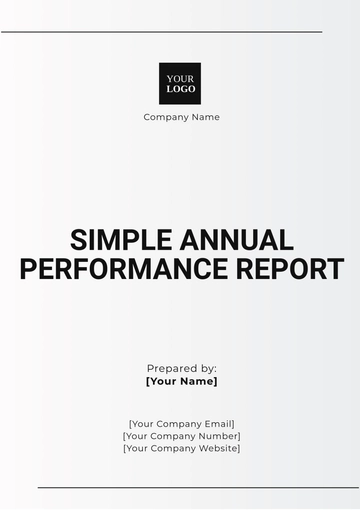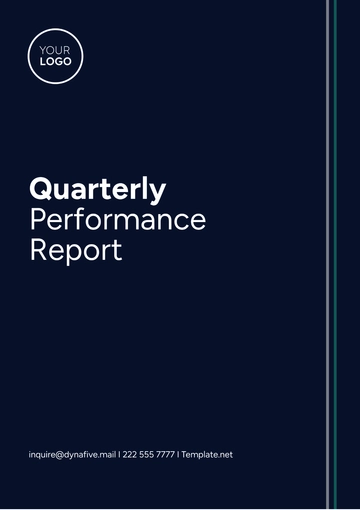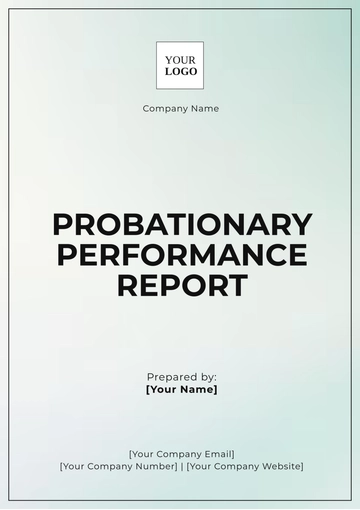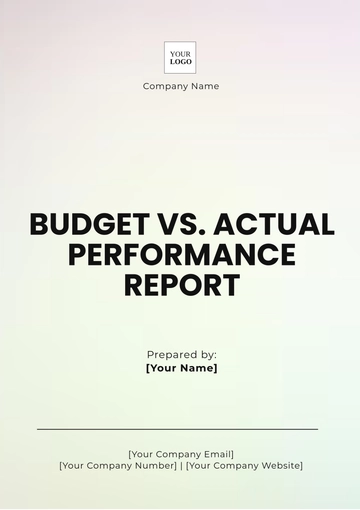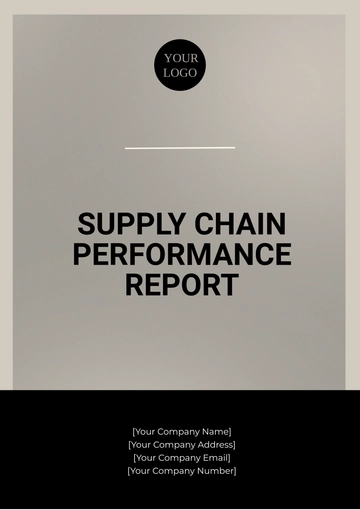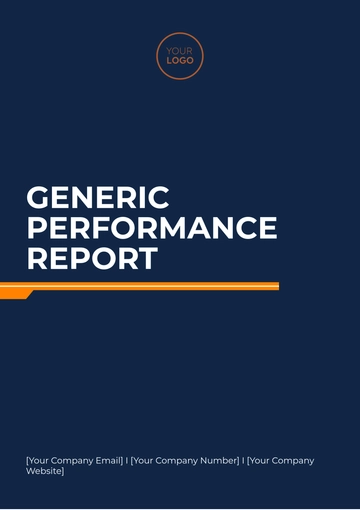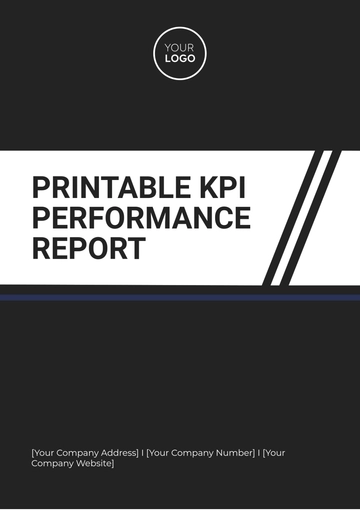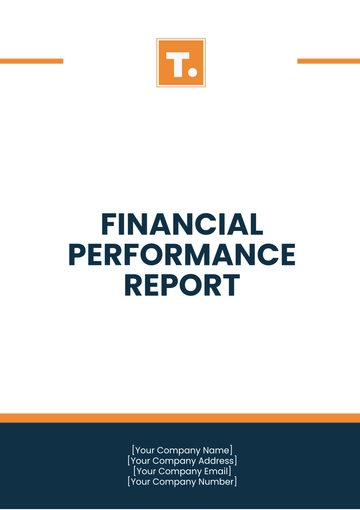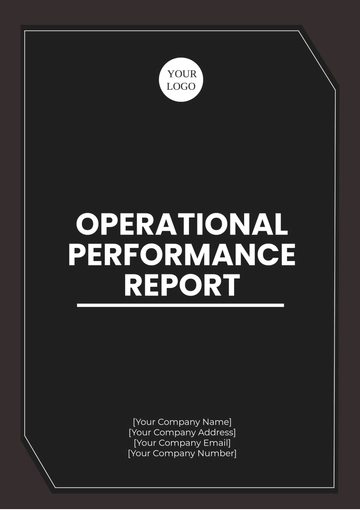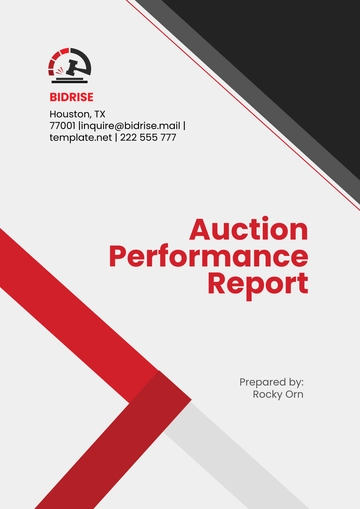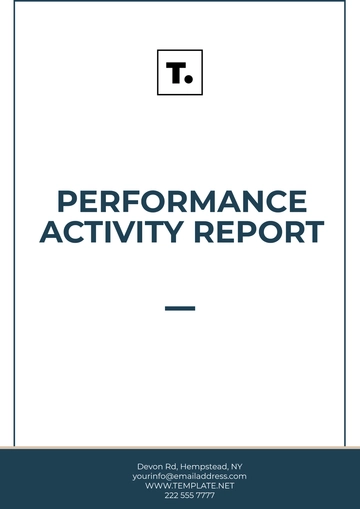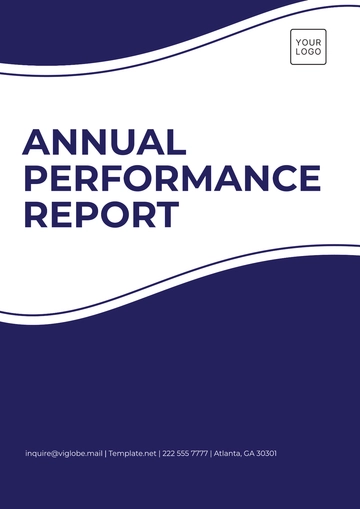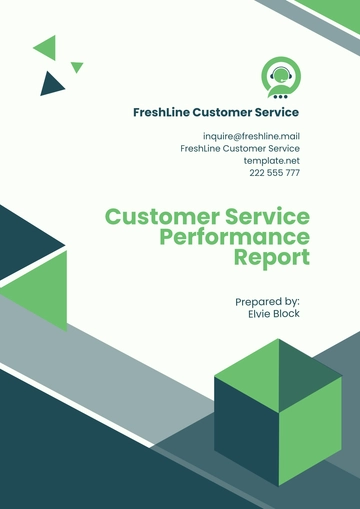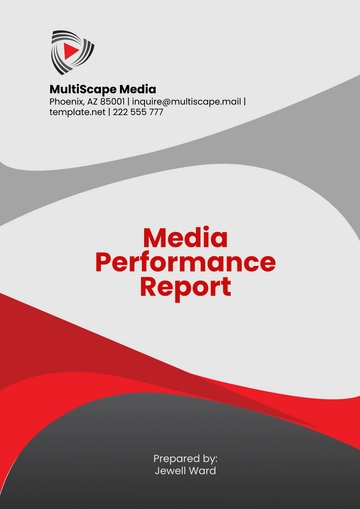Free Media Performance Report
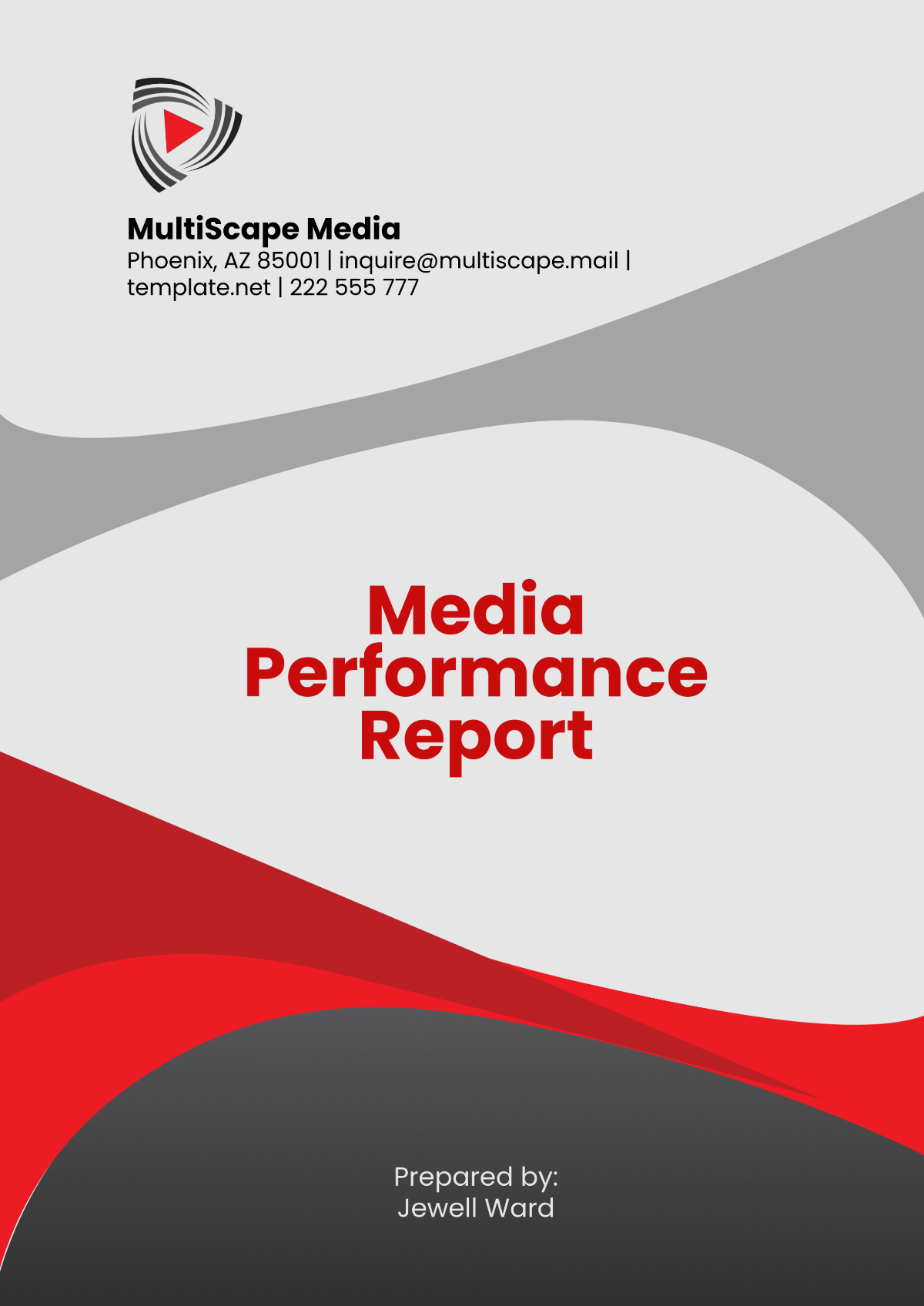
I. Executive Summary
This Media Performance Report for [Your Company Name] evaluates the effectiveness of media campaigns conducted throughout the year 2050. It provides an in-depth analysis of campaign outcomes, insights into key performance metrics, and actionable recommendations for optimizing future strategies. The report underscores performance benchmarks across channels, including digital platforms, traditional media, and hybrid campaigns.
The year 2050 witnessed a significant investment in integrated media strategies across multiple channels, and this report explores the direct correlation between media spending and measurable outcomes. The goal of this analysis is not only to understand the past performance but also to create a roadmap for enhancing the efficiency of media campaigns in the years ahead.
Key Highlights:
Total Media Spend: $[15,000,000]
Total Reach: [200,000,000] unique impressions
ROI from campaigns: [350]%
Best-Performing Channel: Paid Search Advertising
Underperforming Channel: Television
This report is divided into several sections to provide both granular and high-level insights, ranging from spend breakdowns and channel-specific analysis to strategic recommendations for the future. The findings are based on extensive data analysis and are designed to inform strategic decision-making for 2051 and beyond.
II. Objectives and Methodology
A. Objectives
The primary objectives of this Media Performance Report are:
Evaluate Campaign Effectiveness: Measure the success of campaigns against established key performance indicators (KPIs), including engagement, reach, and conversion rates.
Channel-Specific Insights: Provide a detailed look at how each media channel performed, identifying areas for improvement and highlighting channels that exceeded expectations.
ROI Analysis: Quantify the returns generated from media spend to understand the cost-effectiveness of various media investments.
Optimization Recommendations: Provide actionable insights and recommendations for improving future media campaigns, based on the lessons learned in 2050.
Through this structured evaluation, [Your Company Name] seeks to identify both successful strategies and opportunities for optimization in the coming years.
B. Methodology
To ensure that this report provides comprehensive and accurate insights, several data sources and methods were utilized:
Data Sources:
Ad Platform Analytics: The data from various digital ad platforms, such as Google Ads, Facebook Ads, and TikTok Ads, was central to the analysis. These platforms provided data on key metrics like impressions, click-through rates (CTR), and conversions.
Social Media Insights Tools: Tools like Hootsuite and Sprout Social were used to gather insights from platforms like Twitter, LinkedIn, and Instagram.
Third-Party Data Providers: Third-party services provided comparative benchmarks for industry performance and competitor analysis.
Internal Sales and CRM Data: In-house data was used to correlate media performance with actual sales and customer acquisition, offering a direct link between media spend and revenue generation.
Metrics Analyzed:
The following metrics were assessed across all campaigns:Impressions: The total number of times ads were displayed, across all platforms.
Click-through Rate (CTR): The percentage of viewers who clicked on an ad after seeing it, a direct measure of engagement.
Conversion Rate: The percentage of clicks that resulted in a desired action, such as a purchase or sign-up.
Cost Per Click (CPC): The average cost paid for each click in a paid media campaign.
Return on Ad Spend (ROAS): A measure of revenue generated for every dollar spent on advertising.
Cost Per Acquisition (CPA): The cost of acquiring a new customer through paid media channels.
Tools Used:
Tableau: Used for data visualization and creating interactive dashboards.
Excel: Employed for raw data computation and detailed performance tracking.
Power BI: Used to aggregate and analyze the various data sources, providing a unified view of campaign performance.
Data Collection Period:
The data analyzed in this report spans the entire calendar year of 2050, from January to December, capturing all media activities during this period. The data reflects ongoing campaigns as well as one-time events such as product launches and seasonal promotions.
III. Media Spend Overview
A. Total Media Investment
In 2050, [Your Company Name] allocated a total media budget of $[15,000,000] across various media channels. This allocation was determined based on the performance of previous campaigns, the strategic priorities for 2050, and anticipated market trends. A strategic balance was sought between traditional media, such as television and print, and digital media, which has increasingly become the cornerstone of marketing efforts.
Channel | Budget ($) | % of Total Spend |
|---|---|---|
Paid Search Advertising | 4,500,000 | 30% |
Social Media Advertising | 3,750,000 | 25% |
Display Advertising | 2,250,000 | 15% |
Traditional Media | 3,000,000 | 20% |
Other Channels | 1,500,000 | 10% |
Key Insights:
Paid Search Advertising received the largest share of the budget, reflecting the continued effectiveness of search-based campaigns in driving qualified traffic and conversions.
Social Media Advertising accounted for [25]% of total spend, reflecting the increasing importance of platforms like Instagram, TikTok, and Facebook in connecting with consumers.
Traditional Media saw a slight decline in its share of the budget, with a greater focus shifting to digital channels that allow for more precise targeting and measurement of ROI.
B. Spend Allocation by Quarter
The following table shows how the total media budget was allocated across four quarters:
Quarter | Spend ($) | % of Total Spend |
|---|---|---|
Q1 | 3,750,000 | 25% |
Q2 | 4,050,000 | 27% |
Q3 | 3,300,000 | 22% |
Q4 | 3,900,000 | 26% |
Key Insights:
The largest spending occurred in Q2, driven by the launch of a major new product line.
Q1 and Q4 experienced similar spending, as both months featured significant holiday campaigns that required heavy media support.
Q3 saw the lowest spend, reflecting a strategic pause in media investment following the high-intensity campaigns in Q2.
IV. Campaign Performance Analysis
A. Digital Media
1. Paid Search Advertising
Paid Search Advertising remains a critical pillar in [Your Company Name]'s media strategy for 2050, accounting for a substantial portion of the overall media spend. This channel’s effectiveness has been proven through high engagement rates, conversions, and a solid return on investment (ROI). Below is a more detailed breakdown of the performance metrics for Paid Search Advertising:
Metric | Value |
|---|---|
Spend ($) | 4,500,000 |
Impressions | 120,000,000 |
CTR (%) | 4.5% |
Conversion Rate (%) | 7.2% |
Cost Per Acquisition (CPA) | $10.42 |
ROAS (%) | 480% |
Key Insights:
Click-through Rate (CTR): With a CTR of [4.5]%, Paid Search Advertising proved to be highly effective in engaging the target audience. The CTR significantly exceeded industry averages, which typically range from [2.5]% to [3.5]%. This indicates that the keywords chosen, along with the ad copy, were highly aligned with user intent and relevant search queries.
Conversion Rate: A conversion rate of [7.2]% is considered exceptionally high for Paid Search. This reflects that once users clicked on the ads, they were highly likely to complete a transaction or take a desired action. This could be attributed to optimized landing pages, clear calls to action, and high-quality product offerings.
Cost Per Acquisition (CPA): The CPA of $[10.42] is relatively low compared to the average CPA for the industry, which typically falls in the range of $[15]-$[30] depending on the sector. This demonstrates the cost-efficiency of [Your Company Name]'s Paid Search campaigns, maximizing conversions while keeping acquisition costs manageable.
Return on Ad Spend (ROAS): The ROAS of [480]% is a strong indicator of profitability, meaning that every dollar spent on Paid Search generated $[4.80] in revenue. This ROI figure underscores the high efficiency of the paid search strategy.
Recommendations for Future Optimization:
While the campaign performed well, further refinement of long-tail keyword targeting could yield even more cost-effective results, particularly for niche markets or seasonal promotions.
Testing new ad extensions and experimenting with dynamic search ads may help improve visibility and engagement further, reducing reliance on broad keywords and increasing ad relevance.
2. Social Media Advertising
Social Media Advertising continues to be a vital channel for engaging audiences, particularly with younger demographics who are active on platforms like Instagram, TikTok, and Facebook. Social media allows [Your Company Name] to build brand awareness, drive engagement, and encourage customer loyalty through highly visual and interactive content.
Metric | Value |
|---|---|
Spend ($) | 3,750,000 |
Impressions | 80,000,000 |
CTR (%) | 3.8% |
Conversion Rate (%) | 5.5% |
Cost Per Acquisition (CPA) | $15.25 |
ROAS (%) | 320% |
Key Insights:
Impressions and Reach: With over [80,000,000] impressions, Social Media Advertising played a crucial role in increasing the brand's visibility. However, while the reach was significant, the CTR of [3.8]% was slightly lower than that of Paid Search Advertising. This suggests that the audience engagement could be improved through more tailored and dynamic content.
Conversion Rate: The conversion rate of [5.5]% indicates that the social media ads were relatively effective at driving users to complete the desired actions. However, given that paid search advertising generated a higher conversion rate of [7.2]%, there’s room to optimize social media campaigns to boost conversion efficiency.
Cost Per Acquisition (CPA): The CPA for social media ads was $[15.25], which is higher than Paid Search Advertising. This higher CPA might be attributed to the broader targeting and less intent-driven audience on social media platforms compared to search-based ads. However, this could be mitigated by leveraging retargeting strategies to lower acquisition costs.
Return on Ad Spend (ROAS): The ROAS of [320]% indicates that the social media campaigns are still generating a positive return, but it is lower than the performance observed with Paid Search. This suggests that more precise audience targeting and improved creative content could drive higher ROAS in the future.
Recommendations for Future Optimization:
Experiment with user-generated content (UGC) and influencer partnerships to boost engagement and enhance credibility, especially on platforms like TikTok and Instagram where influencers play a significant role in consumer behavior.
Refining audience segmentation and utilizing advanced features such as lookalike audiences and dynamic ad placements could enhance the relevance of the ads and improve both CTR and conversion rates.
3. Display Advertising
Display Advertising represents a significant portion of the digital marketing strategy but did not perform as well as other channels. The primary function of display ads is brand awareness, but they typically have lower engagement and conversion rates compared to direct-response channels like Paid Search.
Metric | Value |
|---|---|
Spend ($) | 2,250,000 |
Impressions | 60,000,000 |
CTR (%) | 1.2% |
Conversion Rate (%) | 2.8% |
Cost Per Acquisition (CPA) | $25.00 |
ROAS (%) | 200% |
Key Insights:
Low CTR and Conversion Rate: The CTR of [1.2]% and conversion rate of [2.8]% are relatively low, indicating that display ads were not as effective at engaging users or driving them to take the desired actions. Display ads tend to have lower engagement than search ads because users are not actively looking for the product or service being advertised at the moment they see the ad.
Cost Per Acquisition: The CPA of $[25.00] is higher than both Paid Search and Social Media Advertising, which suggests that Display Advertising might not be the most cost-effective channel for driving customer acquisition. Display ads generally have higher CPAs due to their broader targeting and less direct intent from users.
Return on Ad Spend (ROAS): With a ROAS of [200]%, the campaign still generated a positive return, but it was lower compared to Paid Search and Social Media. This indicates that while the display ads contributed to brand visibility, their impact on revenue generation was less direct.
Recommendations for Future Optimization:
Moving forward, [Your Company Name] should consider leveraging dynamic remarketing ads, which show more personalized ads to users who have previously interacted with the brand. This type of campaign tends to increase CTR and conversion rates by focusing on warmer leads.
Focusing on highly targeted placements rather than broad, generic ad spaces will help improve the effectiveness of display ads and reduce CPA. More specific targeting (e.g., behavior-based, contextual, or geo-targeting) should be explored to maximize the relevance of display ads.
B. Traditional Media
Traditional media, while still valuable in reaching certain demographics, has seen a decline in its effectiveness when compared to digital channels. The following sections analyze the performance of television and print media in 2050.
1. Television
Television advertising continues to reach large audiences, especially during prime-time programming. However, it is increasingly competing with digital platforms that offer more precise targeting capabilities. Below is the breakdown of television advertising performance:
Metric | Value |
|---|---|
Spend ($) | 1,800,000 |
Reach | 25,000,000 |
Impressions | 40,000,000 |
Cost Per Thousand (CPM) | $45.00 |
ROI (%) | 120% |
Key Insights:
Reach and Impressions: Television advertising provided [25,000,000] people with exposure to the campaign, resulting in a high number of impressions ([40,000,000]). Despite this, the effectiveness of TV ads is challenged by the inability to track engagement and conversions directly.
Cost-Effectiveness: The Cost Per Thousand (CPM) rate of $[45.00] is higher than digital channels, which offer more granular tracking and optimization opportunities. This suggests that TV ads are less cost-effective when compared to digital options for driving conversions.
ROI: The ROI of [120]% indicates that while TV ads contributed to brand awareness and visibility, the returns were not as significant as those seen from digital media, particularly paid search.
Recommendations for Future Optimization:
Given the broader reach and lower targeting precision, television ads should focus more on niche audiences or specific programming to ensure better relevance and effectiveness. Advertisements during prime-time events or live sports could be strategically paired with social media campaigns for better impact.
V. Recommendations for Future Campaigns
As we look toward 2051 and beyond, it is clear that [Your Company Name] can further optimize its media strategy to drive higher ROI and improve overall performance across all channels. Based on the analysis of the 2050 campaign, several key recommendations emerge that can serve as actionable steps for future campaigns. These recommendations aim to refine targeting, enhance creative content, and optimize resource allocation for maximum impact.
1. Invest More in Digital Media
The success of Paid Search Advertising and Social Media Advertising in 2050 clearly demonstrates the significant value digital platforms bring to [Your Company Name]'s overall media strategy. These channels provided both high engagement and efficient conversion rates, especially when compared to traditional media such as television and print.
Reallocate Budget: It is recommended that [Your Company Name] allocate a larger portion of the marketing budget to digital media in 2051. This shift will allow for more precise targeting and performance tracking, leading to better outcomes at lower costs. A portion of the traditional media budget, particularly for television and print, should be reallocated to digital campaigns that yield higher ROI.
Target Younger Audiences: Younger demographics, especially those under [35] years old, are more likely to engage with digital platforms than traditional media. To maximize reach and conversions, campaigns should be tailored to these tech-savvy groups, using platforms such as TikTok, Instagram, and YouTube. Additionally, creating highly targeted campaigns based on data-driven insights will increase relevance and reduce wasted spend.
Explore New Digital Formats: Expanding into newer ad formats such as video ads on social media platforms, interactive display ads, or shoppable posts on Instagram could create new opportunities for engagement. In particular, interactive ads have been shown to significantly improve conversion rates, as users are more likely to engage with content that requires their participation.
2. Enhance Display Advertising Strategy
While Display Advertising produced decent results, its lower engagement and ROI suggest that there are opportunities for improvement. Here are some strategies for enhancing the effectiveness of future display ads:
Implement Dynamic Remarketing: One of the most effective ways to improve the performance of display ads is by using dynamic remarketing. This strategy shows personalized ads to users who have previously interacted with the brand or visited the website. Remarketing ads have been shown to significantly improve conversion rates, as they target individuals who have already demonstrated interest in the product or service.
Focus on More Precise Targeting: Display advertising often suffers from broad targeting, which can lead to low engagement and higher costs. To combat this, campaigns should focus on more specific targeting, such as geo-targeting, contextual targeting, and behavioral targeting. Using data-driven insights to understand where your target audience spends time online and crafting ads based on their behaviors can significantly improve performance.
Use Rich Media and Interactive Formats: To capture the attention of users, consider using rich media ads that combine animation, video, and interactive elements. These ads are more engaging and can drive higher CTRs compared to static display ads.
Test Different Creative Strategies: A/B testing of various creative formats is essential for improving performance. For example, testing different ad copy, images, or even call-to-action phrases can help identify what resonates most with the audience and refine the messaging strategy.
3. Optimize Social Media Campaigns
Social media platforms offer an opportunity to engage users directly and create long-term relationships with consumers. However, to improve the ROI of social media campaigns, the following strategies should be implemented:
Leverage Influencers and User-Generated Content (UGC): Collaborating with influencers and encouraging user-generated content can boost engagement and credibility. Influencers are particularly effective on platforms like Instagram and TikTok, where their followers often trust their recommendations. UGC, on the other hand, makes the brand feel more authentic and allows for natural social proof. Engaging with influencers and showcasing real customer experiences can increase trust and drive conversions.
Refine Audience Targeting: Social media platforms offer sophisticated tools for targeting specific user segments based on demographics, interests, and behaviors. In 2051, [Your Company Name] should take full advantage of these tools, particularly lookalike audiences and interest-based targeting, to ensure ads are reaching the most relevant individuals. A more focused targeting strategy will help improve both the CTR and conversion rates.
Experiment with New Formats: Video and live streaming content continue to perform well on platforms like Instagram, TikTok, and Facebook. Experimenting with live events or product demos can help connect with users in real-time, building deeper engagement. Additionally, experimenting with shoppable posts on social platforms can streamline the customer journey by allowing users to purchase directly from the ad.
4. Optimize Television Advertising for Niche Audiences
Although television continues to be a viable medium for reaching large audiences, its broad reach may not always result in high engagement or ROI. To maximize the effectiveness of television advertising in 2051, [Your Company Name] should consider:
Focusing on Niche Programming: Instead of investing heavily in high-cost prime-time slots, future TV campaigns should focus on niche programming that aligns with the brand’s target audience. For example, ads during popular sports events, reality shows, or specific genres (e.g., cooking, health, or tech shows) could improve the relevance of the message.
Integrate TV and Digital Campaigns: One of the most effective strategies in modern media is the integration of television with digital channels. For instance, TV ads should encourage viewers to engage with the brand on social media or through a dedicated website. This multi-channel approach allows for better tracking of conversions and enables the use of more precise targeting and retargeting strategies.
Increase Ad Frequency: By increasing the frequency of ads during critical events, it is possible to reinforce brand messaging and drive consumer recall. However, ad frequency should be managed carefully to avoid over-saturation, which can lead to diminishing returns.
5. Review and Reduce Television Spend
The results from the 2050 campaign show that Television continues to be the least effective channel in terms of ROI. As consumer behavior increasingly shifts toward digital platforms, print media has seen a steady decline in engagement, particularly among younger audiences.
Reduce Print Budget: Given its low ROI of [60]%, it is advisable for [Your Company Name] to significantly reduce the allocation to print advertising and shift those resources toward more effective digital channels. Print media, while still valuable in certain niche markets, is no longer the primary means to reach a broad audience in 2050 and beyond.
Target Specific Markets: If print advertising is deemed necessary, it should be used selectively in markets where it still holds value. For example, niche publications with a strong, loyal readership or highly localized campaigns may still benefit from print ads.
VI. Conclusion
The media performance analysis for 2050 offers valuable insights into which channels drove the best results and which areas require optimization for future campaigns. The performance of Paid Search Advertising and Social Media Advertising in particular stands out as the key drivers of success, generating strong engagement and exceptional ROI. These digital channels offer the ability to track performance in real time, making them highly effective for future media strategies.
On the other hand, Television, while still playing a role in brand visibility, have shown diminishing returns. As such, [Your Company Name] must adapt by refining its approach to these traditional channels, focusing on niche targeting and integration with digital campaigns. The recommendations outlined in this report are aimed at optimizing media spend, improving targeting strategies, and increasing the overall ROI for 2051 and beyond.
By continuing to leverage the power of digital advertising, optimizing traditional media efforts, and embracing emerging technologies, [Your Company Name] is poised for sustained success in the ever-evolving media landscape. The future is digital, and with the right strategies in place, [Your Company Name] can ensure its continued growth and relevance in the years ahead.
- 100% Customizable, free editor
- Access 1 Million+ Templates, photo’s & graphics
- Download or share as a template
- Click and replace photos, graphics, text, backgrounds
- Resize, crop, AI write & more
- Access advanced editor
Evaluate your media efforts with the Media Performance Report Template from Template.net. This editable and customizable template allows you to track metrics and analyze results. Use the AI Editor Tool to create insightful reports for your campaigns.
You may also like
- Sales Report
- Daily Report
- Project Report
- Business Report
- Weekly Report
- Incident Report
- Annual Report
- Report Layout
- Report Design
- Progress Report
- Marketing Report
- Company Report
- Monthly Report
- Audit Report
- Status Report
- School Report
- Reports Hr
- Management Report
- Project Status Report
- Handover Report
- Health And Safety Report
- Restaurant Report
- Construction Report
- Research Report
- Evaluation Report
- Investigation Report
- Employee Report
- Advertising Report
- Weekly Status Report
- Project Management Report
- Finance Report
- Service Report
- Technical Report
- Meeting Report
- Quarterly Report
- Inspection Report
- Medical Report
- Test Report
- Summary Report
- Inventory Report
- Valuation Report
- Operations Report
- Payroll Report
- Training Report
- Job Report
- Case Report
- Performance Report
- Board Report
- Internal Audit Report
- Student Report
- Monthly Management Report
- Small Business Report
- Accident Report
- Call Center Report
- Activity Report
- IT and Software Report
- Internship Report
- Visit Report
- Product Report
- Book Report
- Property Report
- Recruitment Report
- University Report
- Event Report
- SEO Report
- Conference Report
- Narrative Report
- Nursing Home Report
- Preschool Report
- Call Report
- Customer Report
- Employee Incident Report
- Accomplishment Report
- Social Media Report
- Work From Home Report
- Security Report
- Damage Report
- Quality Report
- Internal Report
- Nurse Report
- Real Estate Report
- Hotel Report
- Equipment Report
- Credit Report
- Field Report
- Non Profit Report
- Maintenance Report
- News Report
- Survey Report
- Executive Report
- Law Firm Report
- Advertising Agency Report
- Interior Design Report
- Travel Agency Report
- Stock Report
- Salon Report
- Bug Report
- Workplace Report
- Action Report
- Investor Report
- Cleaning Services Report
- Consulting Report
- Freelancer Report
- Site Visit Report
- Trip Report
- Classroom Observation Report
- Vehicle Report
- Final Report
- Software Report
